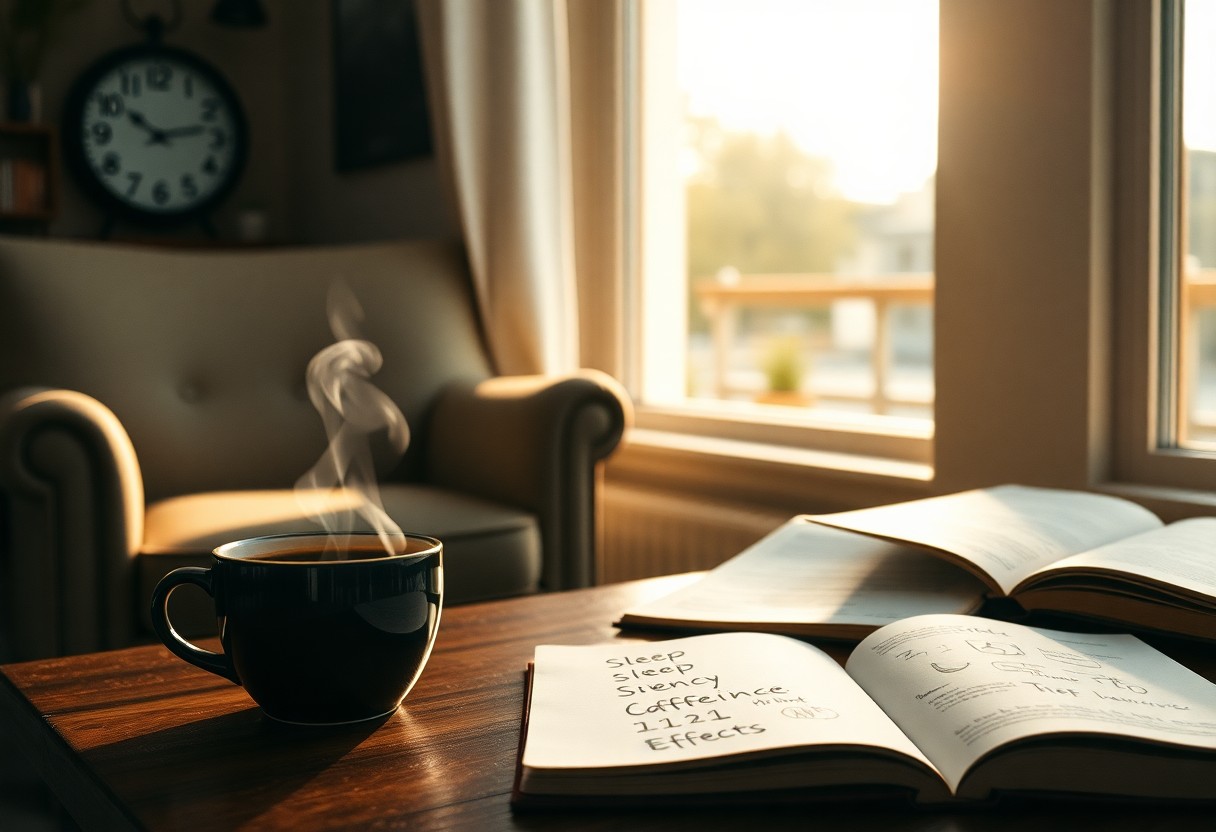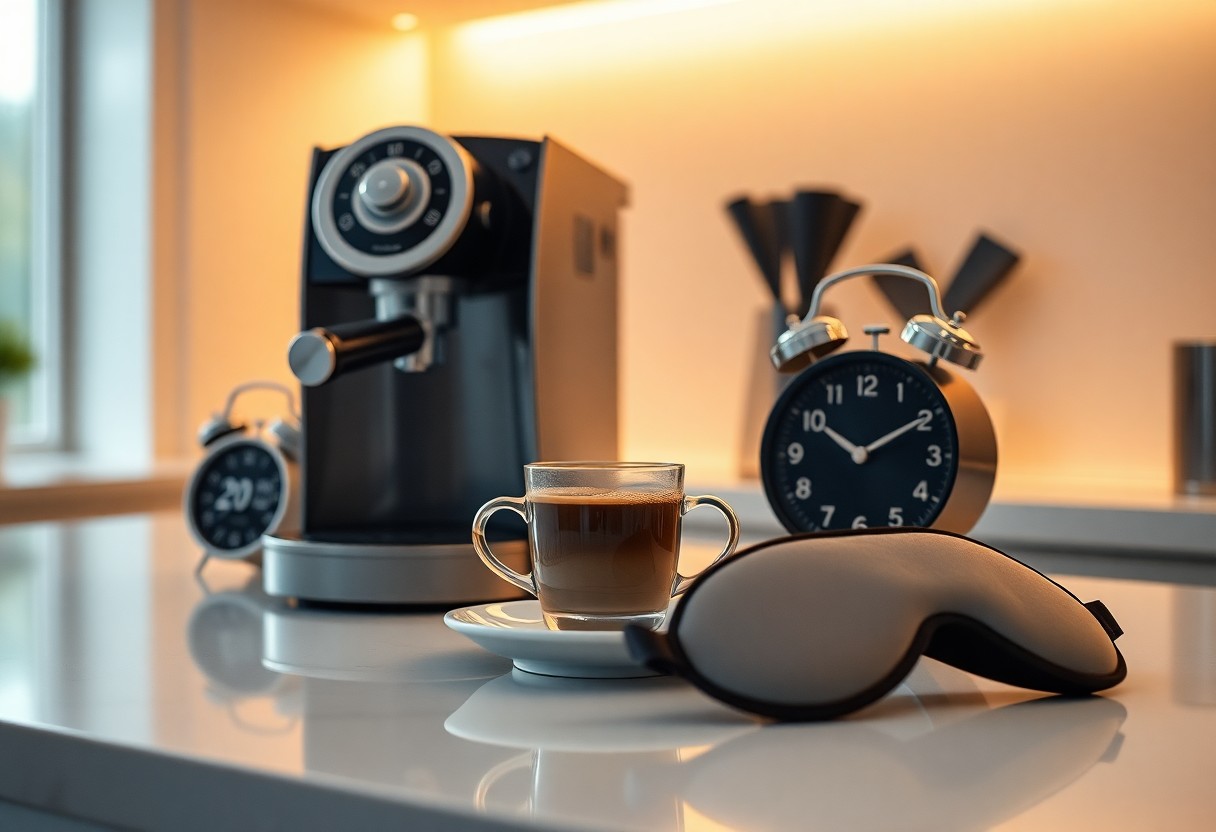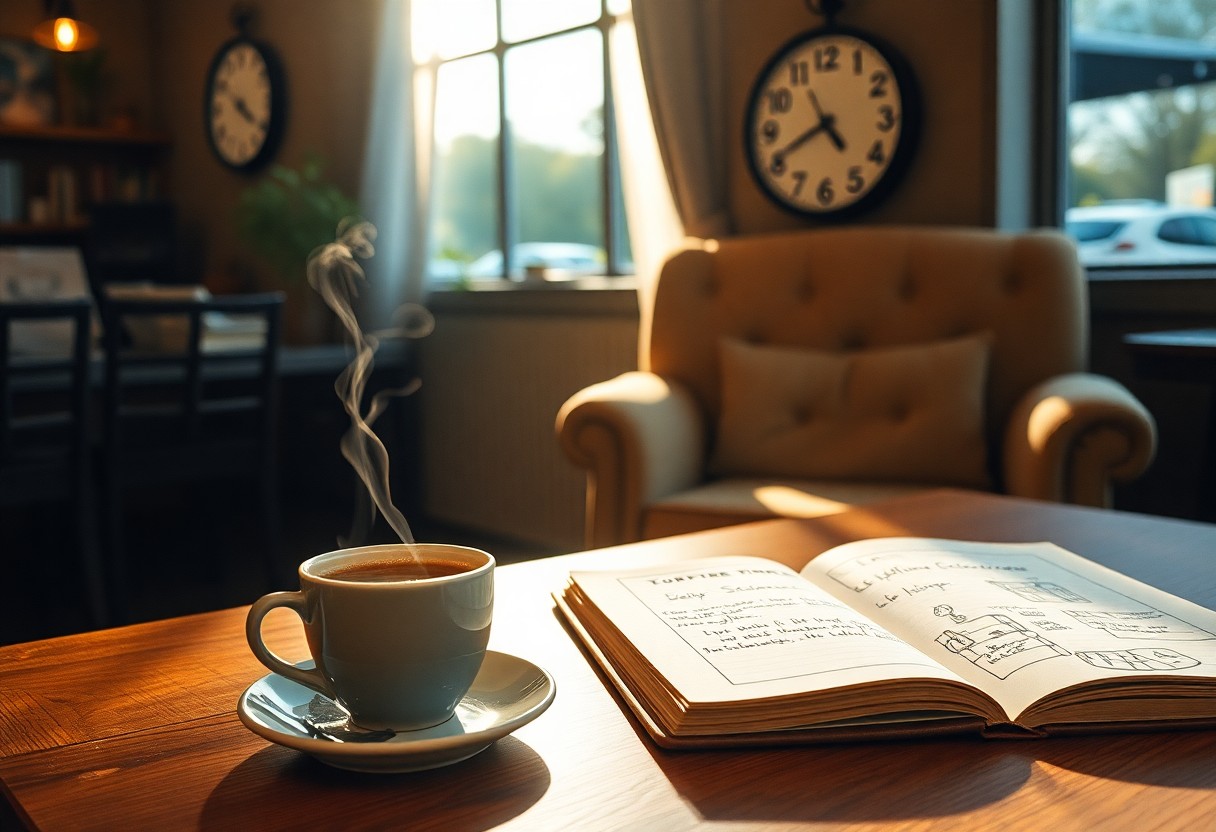Many people struggle with fatigue and productivity during the day, but coffee naps can be a game changer. By strategically timing a short nap after consuming coffee, you can enhance your alertness and energy levels. In this blog post, you will learn why this unique combination is effective and how to perfectly time your coffee nap for optimal results. With the right approach, you can boost your performance and tackle your tasks with renewed vigor.
Key Takeaways:
- Coffee naps combine the effects of caffeine and short sleep, enhancing alertness and performance more effectively than either alone.
- The timing is vital: consuming coffee before a 20-minute nap allows the body to absorb caffeine while resting, maximizing benefits upon waking.
- These naps are best timed when natural energy dips occur, such as mid-afternoon, to help mitigate fatigue and improve focus without oversleeping.

The Neuroscience of Sleep and Caffeine
Understanding the interplay between sleep and caffeine reveals why coffee naps can be so effective. Neurotransmitters and hormones orchestrate your alertness and energy levels, with caffeine operating primarily on the brain’s adenosine system. Intertwining your sleep cycles with caffeine intake can optimize brain performance, enhancing cognitive functions like memory, focus, and creativity. By tapping into the brain’s natural rhythms, you can unlock greater productivity and mental clarity.
How Sleep Cycles Enhance Cognitive Function
Your brain goes through distinct sleep cycles that play a vital role in consolidating memories and processing information. Each cycle, typically lasting about 90 minutes, alternates between Non-REM and REM sleep, with the latter being particularly important for learning and problem-solving. When you integrate short naps into your routine, especially after caffeine, you can enhance synaptic connections, supporting better retention and creativity upon waking.
The Role of Adenosine in Sleepiness and Alertness
Adenosine, a neurotransmitter that promotes sleep, builds up in your brain the longer you stay awake. As adenosine levels rise, you begin to feel increasingly tired. Consuming caffeine blocks adenosine receptors, effectively reducing your perception of fatigue and enhancing alertness. Therefore, by strategically timing coffee intake with short naps, you can exploit both caffeine’s stimulating effects and the restorative benefits of sleep.
As you stay awake longer, adenosine accumulates, leading to that familiar feeling of sluggishness. This buildup signals your body that it’s time for rest. Caffeine steps in as an antagonist, occupying adenosine receptors and temporarily alleviating fatigue. However, after a short nap, the adenosine receptors become free again, while caffeine has yet to fully activate, resulting in a two-fold boost: the refreshing effects of sleep combined with the energetic lift of caffeine, amplifying your alertness and cognitive functions significantly.

The Perfect Timing: Syncing Naps with Caffeine
To maximize the benefits of your coffee nap, you must master the art of timing. Perfect synchronization hinges on two key factors: the duration of your nap and your caffeine consumption. A well-timed coffee nap not only enhances your energy levels but can also sharpen your focus, making it imperative to find that optimal window to reap the greatest rewards.
The Optimal Duration: Finding Your Sweet Spot
A nap lasting between 10 to 20 minutes serves as the ideal sweet spot for most people. This brief period prevents you from entering deep sleep, which can leave you feeling groggy instead of refreshed. In this window, you become more alert without sabotaging nighttime sleep, balancing rejuvenation and productivity seamlessly.
Timing Your Intake: When to Drink Coffee for Maximum Benefits
For the best results, consume a cup of coffee just before your nap. The typical caffeine hit takes about 20 minutes to kick in, aligning perfectly with your short rest period. This way, as you wake up from your nap, the caffeine will be in full effect, leaving you feeling significantly more alert and energized.
The caffeine metabolizes in your system, interacting with your body’s adenosine—responsible for sleepiness. By drinking coffee immediately prior to your nap, you prime your body to absorb caffeine while simultaneously allowing your mind to refresh. This synergy between your caffeine intake and napping routine enhances cognitive function and energy levels, setting the stage for a productive day. As you master this timing rhythm, you’ll notice an improvement in not just alertness but creativity and problem-solving abilities, making it easier to tackle the challenges ahead.
Crafting Your Coffee Nap Routine
Establishing a coffee nap routine can significantly boost your productivity and alertness. Start by choosing a time of day when you naturally experience a dip in energy, ideally in the early afternoon after lunch. Make sure to consume about 200 mg of caffeine, equivalent to two 8-ounce cups of coffee, immediately before drifting off for 20 minutes. Setting an alarm is important to ensure you wake up refreshed and not groggy. Regularly repeating this routine can help your body adapt and enhance the benefits over time.
Dos and Don’ts for Effective Napping
To maximize the benefits of your coffee naps, follow a few simple dos and don’ts. Do find a comfortable position and create a relaxing atmosphere. Avoid caffeine later in the day to optimize sleep cycles and don’t extend your nap past 20 minutes, as longer sleep might lead to grogginess.
Creating an Environment for Success
Your nap environment plays a vital role in the effectiveness of your coffee nap. A dark, quiet space helps signal to your body that it’s time to rest. Consider using an eye mask and earplugs to block out distractions. Additionally, maintaining a comfortable temperature in the room can help you fall asleep quickly. Try to avoid locations with high foot traffic or noise to ensure your short rest remains undisturbed.
Think about adding personal touches to your napping area. Familiar scents, like lavender or chamomile, can promote relaxation and make it easier to fall asleep. Keeping your napping area well-ventilated contributes to comfort, enhancing your chances of a restful 20 minutes. Consistency in location can also cue your brain that it’s time to take a power nap, allowing you to drift off more easily and enjoy the full rejuvenating effect of your coffee nap.
The Productivity Boost: Real-World Applications
Implementing coffee naps can lead to noticeable improvements in your productivity. Many professionals report enhanced concentration, better problem-solving skills, and increased energy levels after indulging in this unique strategy. The combination of caffeine’s stimulating effects and the restorative power of a short nap creates a potent formula for tackling challenging tasks and maintaining peak performance throughout the day.
Testimonies from Professionals Who Use Coffee Naps
Countless individuals across various industries swear by coffee naps for their effectiveness. From software developers meeting tight deadlines to teachers requiring alertness during long days, professionals have shared experiences of improved focus and creativity. “After just a 20-minute coffee nap, I’m back to my best self,” one marketing executive attests, highlighting the simple yet transformative nature of this practice.
How Coffee Naps Enhance Workplace Efficiency
Integrating coffee naps into your work routine can elevate overall workplace efficiency. By strategically using short sleep paired with caffeine, you combat the afternoon slump and minimize fatigue. This approach not only boosts individual productivity but also fosters a culture of well-being and performance within teams. Further, organizations adopting this practice report higher employee satisfaction, translating into reduced burnout rates and improved team dynamics.
Employers who embrace coffee naps often witness a ripple effect on performance metrics. For instance, a study indicated that employees utilizing coffee naps increased productivity by over 30% in task completion rates. This phenomenon stems from improved cognitive function and mood, resulting in more creative and focused contributions. By creating an environment that encourages mindful breaks, companies can unlock their workforce’s full potential, ultimately benefiting both staff and organizational objectives.
The Long-Term Benefits of Implementing Coffee Naps
Incorporating coffee naps into your daily routine offers significant long-term benefits that extend beyond a simple energy boost. Regularly engaging in this practice can enhance cognitive function, improve mood, and increase your overall productivity. As your body becomes acquainted with this rhythm, you may find that you not only feel more awake but also experience a sharper focus and creativity throughout the day.
Reducing Overall Fatigue and Burnout
By taking short, caffeine-fueled naps, you effectively combat fatigue and reduce the likelihood of burnout. Frequent coffee napping helps you replenish your energy reserves, keeping stress and irritability at bay. This consistent small recharge can lead to better resilience against daily challenges, allowing you to tackle tasks with renewed vigor and focus.
Building a Habit for Sustained Energy Levels
Establishing a habit of coffee napping can significantly transform your energy levels throughout the day. Initially, you might find it challenging to integrate this practice, but consistency will lead to better results. Over time, your body starts to anticipate the benefits, allowing caffeine to work more effectively while you rest, resulting in heightened alertness and enhanced mood.
Creating a coffee nap routine encourages you to listen to your body’s natural rhythms. By tuning into your energy dips, you can strategically plan your coffee intake and rest periods. For instance, if you routinely hit a slump around mid-afternoon, consistently timing your coffee nap can ensure you stay alert and productive during those critical hours. This behavioral conditioning not only improves your current focus but also builds a sustainable energy strategy for the long term, making each day smoother and more enjoyable.
To wrap up
As a reminder, coffee naps can be an effective strategy for enhancing your alertness and cognitive performance. By timing your caffeine intake perfectly with a short nap, you can maximize the benefits of both, allowing your body and brain to rejuvenate efficiently. Aim for a quick 20-minute nap immediately after drinking coffee for optimal results. This unique combination offers you a simple yet powerful tool to combat fatigue, boost productivity, and improve overall well-being when timed correctly.
FAQ
Q: What is a coffee nap and how does it work?
A: A coffee nap is a strategic combination of drinking coffee and taking a short nap. The idea is to consume a cup of coffee and then immediately take a 20-minute nap. The caffeine takes about 20 minutes to affect the brain, which coincides with the time it takes for a short nap to refresh you. When you wake up, the caffeine is at its peak, enhancing alertness and making you feel more awake than if you had just napped or consumed coffee alone.
Q: How long should a coffee nap be for optimal results?
A: For the best results, a coffee nap should last about 20 minutes. This duration is long enough to allow your brain to rest and recover, but short enough to avoid entering a deeper sleep cycle that can leave you feeling groggy. The combination of a short nap with the timing of caffeine absorption maximizes the benefits of both.
Q: Is there an ideal time of day to take a coffee nap?
A: The optimal time for a coffee nap generally falls in the early to mid-afternoon, typically between 1 PM and 3 PM. This timeframe aligns with the body’s natural circadian rhythm, which often experiences a dip in alertness. By timing your coffee nap during this slump, you can increase your energy levels and productivity for the remainder of the day.
Q: Are there any downsides to coffee naps?
A: While coffee naps can be effective, they may not be suitable for everyone. Individuals sensitive to caffeine might experience jitters or difficulty sleeping later in the day. Furthermore, if taken too late in the afternoon, a coffee nap could interfere with nighttime sleep. It’s important to listen to your body and determine what works best for your energy levels and sleep patterns.
Q: Can other types of drinks be used instead of coffee in a coffee nap?
A: While coffee is the most commonly used beverage for this technique due to its high caffeine content, other caffeinated drinks like tea or energy drinks can also be effective. However, the caffeine levels in these drinks may differ, so it’s important to adjust the timing and quantity accordingly. Always consider personal tolerance and the effects of different sources of caffeine when experimenting with variations of coffee naps.
